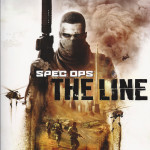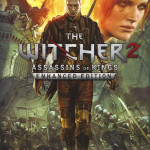Every gaming website under the sun has been posting their Game of the Year picks for 2012, so why not have Strategy Guides of the Year? There were several notable strategy guides this year that I was incredibly honored to have cross my desk and my controllers. It was actually hard to pick a top 5 of all of the guides I had, especially since more than five received a 5/5 rating this year. But after much obsessing and analysis this week, I’m proud to dub the following strategy guides as the best Strategy Guides of 2012.
5. Paper Mario: Sticker Star Strategy Guide
 If it was not for this strategy guide, I would not have gotten far in the game at all, much less finished the game with a completed Sticker Museum. It held my hand in every way I needed it to, which was sadly quite a lot, due to my inexperience with Super Mario games.
If it was not for this strategy guide, I would not have gotten far in the game at all, much less finished the game with a completed Sticker Museum. It held my hand in every way I needed it to, which was sadly quite a lot, due to my inexperience with Super Mario games.
Most importantly, the layout of the strategy guide was presented in an incredibly efficient manner, so it was extremely easy to find out which levels you needed to revisit, what you needed to bring with you to every visit and revisit, and the most efficient path you need to take to complete the level and pick up all collectibles.
Thank you, for making my first foray into a Mario game since Super Mario Bros. 3 a surprisingly pleasant experience.
4. Spec Ops: The Line Strategy Guide
 Spec Ops: The Line wasn’t a particularly difficult game in that it didn’t require too much strategy to get through firefights, not unlike most other military shooters. The most I used it for firefight help was for tips on which gun to use in certain situations, such as the shotgun tip when that heavy seems to disappear and reappear closer to Walker in the mall. However, Spec Ops was not as much about being a shooter as it was telling a story and making the player feel like the worst person on the planet. The strategy guide was more important for outlining all of the choices Walker had to make, and it was thanks to the guide that I was able to make the non-obvious, non-stated third choices available.
Spec Ops: The Line wasn’t a particularly difficult game in that it didn’t require too much strategy to get through firefights, not unlike most other military shooters. The most I used it for firefight help was for tips on which gun to use in certain situations, such as the shotgun tip when that heavy seems to disappear and reappear closer to Walker in the mall. However, Spec Ops was not as much about being a shooter as it was telling a story and making the player feel like the worst person on the planet. The strategy guide was more important for outlining all of the choices Walker had to make, and it was thanks to the guide that I was able to make the non-obvious, non-stated third choices available.
What I appreciated the most, was that while the strategy guide laid out the choices you could make, it really did not spoil how the choices affected the story. For example, when it came down to choosing to save that CIA agent or saving the hostages, the guide never once said that no matter what you choose, the CIA agent dies. If it had, I would have made a far different choice. On the same token, the strategy guide pointed out that there were four different endings, explained how to get them, but then never detailed what the endings contained. When I unlocked all four endings, I was able to be horrified without expectation each time.
Also, if it wasn’t for the strategy guide, I wouldn’t have found all of the collectibles, which really added to overall plot.
3. The Witcher 2 Strategy Guide
 The Witcher 2, by far, is the hardest video game I have ever played, even with the added-on tutorial for the Enhanced Edition. After taking over two hours just to get through the first scene in the game (not the first battle…don’t be mean), I had to knock the difficulty down to Easy, and even then, it was no picnic. The strategy guide made sure I came fully prepared to every situation with potions, traps, and spells, thus ensuring I only died once or twice in each battle instead of fifteen times. I have never had to bring so many specific items into every battle in any other game I played. Usually it’s bring a health potion, a bomb, maybe a specific weapon. In The Witcher 2, you need brown oil for your sword (now are you fighting a monster or a human? that affects which sword you coat), a potion for rejuvenating health at a faster rate, fire traps, a grapeseed bomb, and make sure you have learned a specific rune. Um, what?
The Witcher 2, by far, is the hardest video game I have ever played, even with the added-on tutorial for the Enhanced Edition. After taking over two hours just to get through the first scene in the game (not the first battle…don’t be mean), I had to knock the difficulty down to Easy, and even then, it was no picnic. The strategy guide made sure I came fully prepared to every situation with potions, traps, and spells, thus ensuring I only died once or twice in each battle instead of fifteen times. I have never had to bring so many specific items into every battle in any other game I played. Usually it’s bring a health potion, a bomb, maybe a specific weapon. In The Witcher 2, you need brown oil for your sword (now are you fighting a monster or a human? that affects which sword you coat), a potion for rejuvenating health at a faster rate, fire traps, a grapeseed bomb, and make sure you have learned a specific rune. Um, what?
In addition, The Witcher 2 is riddled with side quests that aren’t always obvious to unlock, meaning that not every side quest is triggered by talking to every NPC in town. I was already having trouble staying alive in battle, so you better believe I wanted to do as many side quests as possible to level up Geralt.
Thinking of playing The Witcher 2 and you have no prior experience in this series? Do not go alone. Take this.
2. Final Fantasy XIII-2 Strategy Guide
 As I said when I reviewed the Final Fantasy XIII-2 strategy guide, I was extremely hesitant about the contents of this guide. I was less than pleased with the Final Fantasy XIII strategy guide, and that really carried over to the guide’s sequel, whether that was fair or not. The strategy guide ended up, as you can guess, blowing my mind with how absolutely stellar it was. The strategy guide sat by my side, literally, during the 60+ hours I played the game. The strategies for boss fights were flawless, I had no problems completing all of the side quests and alternate endings, and I found all the collectibles (I cared about finding) with ease.
As I said when I reviewed the Final Fantasy XIII-2 strategy guide, I was extremely hesitant about the contents of this guide. I was less than pleased with the Final Fantasy XIII strategy guide, and that really carried over to the guide’s sequel, whether that was fair or not. The strategy guide ended up, as you can guess, blowing my mind with how absolutely stellar it was. The strategy guide sat by my side, literally, during the 60+ hours I played the game. The strategies for boss fights were flawless, I had no problems completing all of the side quests and alternate endings, and I found all the collectibles (I cared about finding) with ease.
If I had wanted to complete the bestiary journal, I know I could have, but I was too darn lazy to hunt all of those creatures down. I had already devoted enough time to collecting most of the shards; seeing the super-secret ending just wasn’t enough to keep me going. But at least I know that the strategy guide would have led me to each beast and taught me how to defeat it the first or second try. Sometimes, that’s all that matters.
1. Mass Effect 3 Strategy Guide
 I swear, selecting the Mass Effect 3 strategy guide as the top strategy guide of 2012 isn’t some sly move to push my love and affection for Mass Effect. If you don’t believe me, go read my review of the Mass Effect 2 strategy guide, which was terrible. In fact, it was so bad, when I learned Prima Games was doing Mass Effect 3 strategy guide–which of course they were, since they work exclusively with EA–my heart sank as low as it did when I learned Piggyback was publishing the strategy guide for Final Fantasy XIII-2. Like that strategy guide, the strategy guide for Mass Effect 3 greatly exceeded all expectations. Not only did the strategy guide provide excellent strategies for surviving some intense battles–thank you, in particular, for the one-on-one battles with Reapers–but it highlighted how your decisions in previous games affected what decisions you could make in this game. It really showed how sometimes I didn’t make the best decision I could have, even in my Paragon route.
I swear, selecting the Mass Effect 3 strategy guide as the top strategy guide of 2012 isn’t some sly move to push my love and affection for Mass Effect. If you don’t believe me, go read my review of the Mass Effect 2 strategy guide, which was terrible. In fact, it was so bad, when I learned Prima Games was doing Mass Effect 3 strategy guide–which of course they were, since they work exclusively with EA–my heart sank as low as it did when I learned Piggyback was publishing the strategy guide for Final Fantasy XIII-2. Like that strategy guide, the strategy guide for Mass Effect 3 greatly exceeded all expectations. Not only did the strategy guide provide excellent strategies for surviving some intense battles–thank you, in particular, for the one-on-one battles with Reapers–but it highlighted how your decisions in previous games affected what decisions you could make in this game. It really showed how sometimes I didn’t make the best decision I could have, even in my Paragon route.
I also greatly appreciated the fact that they printed the ending pages upside down to prevent accidental spoilers. The only way you were going to see all the different endings and paths you take to get there was if you really, really wanted to. Even then, it didn’t fully “spoil” the endings, which is always important in my book.



Leave a Reply